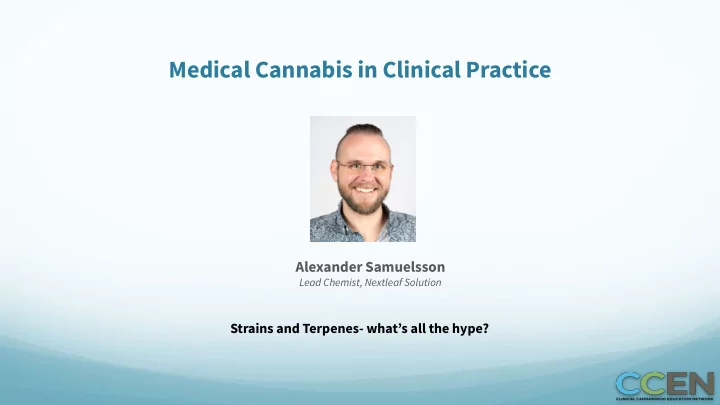

Medical Cannabis in Clinical Practice Alexander Samuelsson Lead Chemist, Nextleaf Solution Strains and Terpenes- what’s all the hype?
Molecules, Receptors, and Physiological Effects, Oh My! How the science of cannabis informs medical rationale... …Or how I learned to love biological first principles.
Cannabis, how does it even work? • What is the physiological rationale for the felt effects of cannabis? • How can we leverage this understanding to better utilize cannabis as a medicine ?
But first, some plant science!
Cannabis Anatomy • • • • • •
Trichome anatomy
Now, onto some biochemistry!
Biosynthesis of Cannabinoids and Terpenes Enzymes called " Terpene synthases " are responsible for converting precursors into specific terpene and terpene classes. Terpene construction via condensation IPP + DMAPP + enzyme -> monoterpene 30 terpene synthase genes recently discovered Judith Booth, Jonathan Page, Jörg Bohlmann. Over 140 terpenes confirmed in Cannabis
Biosynthesis of Cannabinoids and Terpenes
Biosynthesis of Cannabinoids and Terpenes GPP is essential for cannabigerolic acid Cannabinoids in cannabis would not be possible without terpenes
Cannabis Compounds and Receptors Receptors are the physiological base for felt effects from compounds in cannabis • • Cannabidiol Δ9-Tetrahydrocannabinol (CBD) (THC) • • Myrcene α-Pinene
Terpenes – Floral and Functional Isoprene Rule: General rule for creating terpenes through condensation of isoprene units (C5H8) Configuration of terpene condensation leads to variety of isomers
Terpenes – Floral and Functional α β
Terpenes – Floral and Functional Monoterpenes
Terpenes - Analysis
Up next, receptors
Receptor Studies: A Cautionary (Rat)Tail • Most receptor studies are carried out in rat models and knockout transgenic mice then analogized to humans . • Not conclusive! • Gene studies including cloning of human receptors and radio labelling studies show some evidence between mouse models and human effects. • Some parallels • Petrie dish results seldom translate to successful drugs
Receptor Modulation • • •
G Protein Coupled Receptors • GPCRs – G-protein coupled receptors are ubiquitous around the brain and body • Cannabinoid receptors make up a small subsection of GPCR type but make up most of the GPCR density in the brain . • GPCR example Beta adrenergic drug target • salbutamol in puffers. • Beta blockers • GPCRs make up 34% of all approved sales volumes and 180 Billion US annually.
Known Cannabinoid Receptors • CB1 receptors located primarily in the brain, central and peripheral nervous system . • Endogenous : Anandamide and 2-AG • Exogenous : D9-THC • CB2 receptors are also found in low density on some neurons but primarily throughout the body, gut, and immune cells . • Endogenous : 2-AG • Exogenous : CBD, Beta-caryophyllene (cannabimimetic) • “ Orphan GPRs GPR18 and GPR55 show ligand-receptor interactions with cannabinoids and may lead to reclassification and addition of new cannabinoid receptors” • CB3, CB4, maybe CB5 (adopted) receptors for future studies
Cannabinoid Receptors in Humans • • •
TRPs Channel Receptors – “Terpene” Receptors • TRPV1 and other known TRP receptors show terpene affinity . • TRPs modulate calcium channels which play a role in action-potential-induced neurotransmitter release. • Several natural products (e.g. Capsaicin, menthol, gingerol) have been shown to affect channel gating but exact selective pharmacology has yet to be fully developed and understood.
TRPs Channel Receptors • • •
Entourage Effect • Both CB-GPRs and TRPs co-expressed on synaptic and presynaptic clefts • Anandamide has dual action on TRP and CB receptors • Modulate calcium channels , affecting neurotransmitter release/inhibition • Basis for the physiological rationale of the “entourage effect”, still a theory but makes sense
Strain differences
Strain differences
Strain differences
Strain differences
Strain differences
Strain differences
Parting Thoughts • Strains of cannabis impart a variety of effects directly related to the chemical composition and ratios of terpenes and cannabinoids . • Terpenes and Cannabinoids interact with the endocannabinoid system. • Ligand-receptor interactions are the source and mechanism for the variety of effects experienced. • Look to literature , be wary of rat models, and keep in mind that biosynthetic pathways, maps, and our understanding evolve as research progresses . • Think of what is happening at the cellular level then leverage known effects . • Beware small sample sizes! • Medical rationale through receptor-ligand interactions found in studies − Studies launching with greater frequency
THANK YOU! • Special thank you to the sponsors, CCEN, PURESinse, Strainprint, and everyone for listening! • Happy to answer any questions
Recommend
More recommend